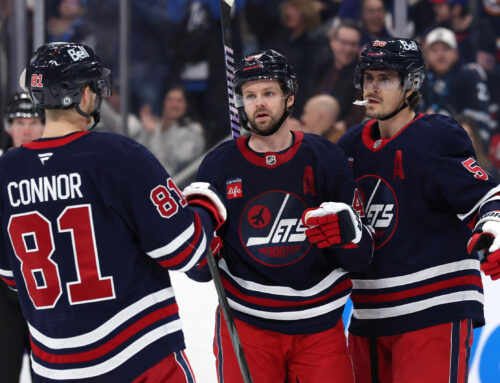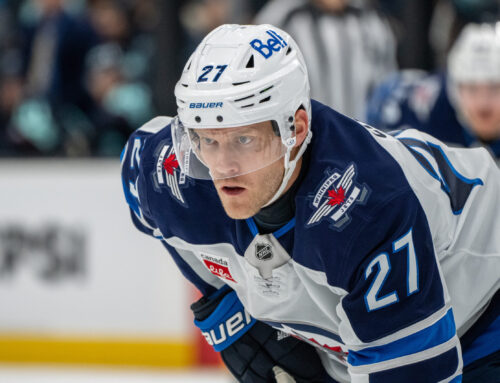
Welcome to week six of our summer series. Like last season, this series is intended to take a look at the teams in the Western Conference one by one. We will do a short recap of what took place, but the deep dive here will be into the players that helped make it so, for better or worse. We will be taking a look at a few players who out or under performed their expectations and be considering whether this performance might just be the new normal.
And now for the technical details. We will be using the Fantasy Hockey Geek tool to get a ranking that combines all of a player’s stats for the searched categories. These ranks are based on a 12 team, head-to-head league, using the categories of goals, assists, power-play points, shots, hits and blocks for forwards/defensemen and wins, saves, save percentage and goals against average for goalies. The idea is to compare this ranking with an expected ranking based on the average draft positions from the start of the year. This process does not necessarily identify who was the most important player to each team but gives us not only an idea of who was a steal/bust on draft day, but where each player was valued going into this season. Player eligibility for this series is based on Yahoo, and draft ranks are based on average draft positions compiled from Yahoo, ESPN and CBS by FantasyPros.
This week: Dallas
Recap:
Dallas finished the 2018-19 regular season as the top Wild Card seed with 93 points. As per usual they did it mostly on the backs of Tyler Seguin, Jamie Benn, and Alexander Radulov. Benn had a bit of a down year, which didn’t help, but Ben Bishop was excellent in net and gave Dallas some of the best goaltending they have seen in years.
Undervalued:
Heiskanen entered 2018-19 as a heralded defensemen thought to be able to step right into the NHL at age 19 and make an impact. He was drafted (if at all) at a pedestrian 235 between Tomas Chabot (great value) and Roman Polak. By the end of the season his value increased to 204th overall. His overall value was hurt a bit by the fact that he rarely hits and infrequently blocks.
His season was a success by any account. He ended up with 33 point in 82 games. In the last five years there are 14 instances of rookie defensemen breaking 30 points, but only Rasmus Dahlin, Heiskanen, Aaron Ekblad, and Mikael Sergachev have done so as teenagers.
|
GP |
Goals |
Assists |
Points |
Points/ Game |
Shots |
S% |
Hits |
PPPts |
Blocks |
PPTOI |
TOI |
|
82 |
12 |
21 |
33 |
0.4 |
182 |
6.6 |
34 |
8 |
71 |
1:40 |
23:07 |
The next question is, what will happen in 2019-20? Will it be the same as 2018-19? Likely not, but for different reasons. In 2018-19 Heiskanen was helped along a bit by a very timely injury to power-play one quarterback John Klingberg. During that injury Heiskanen scored at a 45 point pace and was seeing top unit deployment. Once Klingberg returned Heiskanen dropped down to just below a 30 point pace for the remainder of the season. It wouldn’t be a good idea to draft Heiskanen assuming top line role as that spot still belongs to Klingberg, and we certainly can’t count on a Klingerg injury to boost Heiskanen’s value. It does give us a bit of a glimpse at what Heiskanen is capable of doing with better deployment, even as a teenager.
On the plus side Heiskanen is going to be maturing and his success at such a young age bodes incredibly well for his future. Plus the additions of Joe Pavelski and Corey Perry give Dallas a bit more depth, which should help provide more offensive production at even strength and give the second power-play unit a boost. Overall given he was able to maintain close to a 30 point pace with Kilngerg in the lineup and that he should see some growth as a player, 35-40 points seems a pretty reasonable expectation for 2019-20.
Bishop was drafted as the 75th player overall and the 13th ranked goalie in 2018-19. He was selected right between Matt Murray and Devan Dubnyk. By the end of the season he had shot up significantly in the rankings to 5th overall and the second ranked goalie.
|
Player |
Team |
Position |
FHG Rank |
|
TBL |
G |
2 |
|
|
DAL |
G |
5 |
|
|
MTL |
G |
7 |
|
|
NYI |
G |
8 |
How did it happen? Well Bishop had a career year in 2018-19.
|
GP |
W |
GAA |
SV |
SV% |
QS% |
|
46 |
27 |
1.98 |
1236 |
0.934 |
65.2 |
His games played and win numbers are nothing spectacular, but his other stats most definitely are. His goals against average and save percentage numbers are career bests, and particularly in the case of save percentage, it is not really that close. It is clear that Bishop’s significant change value in 2018-19 came because managers weren’t expecting those excellent numbers.
So what does that mean in 2019-20? Right off the bat we can say that 2018-19’s numbers were a significant improvement from Bishop’s recent seasons. That should give us some pause as to whether or not it will be repeatable. To look a little deeper we can check his penalty kill save percentage. Since that sample size is so small PK save percentage can fluctuate dramatically within a single season. Bishop’s .897 is a reasonable percentage, and certainly doesn’t account for the difference in stat he saw this year. We may have expected to see about four more goals scored against with the workload he saw, but nothing dramatic, so far so good.
As a team Dallas allowed the 3rd fewest goals against with 133. Bishop was obviously a big part of that, but we would have expected them to allow quite a few more goals against across the season as Dallas ranked 11th overall in expected goals against. The difference is even more dramatic for Bishop himself. Bishop saved about 32 goals more than the average goalie, when over the last five seasons he averaged about 1.2 goals saved above average. If he had been consistent with that average in 2018-19 his save percentage would have dipped all the way down to .912 a significant drop with his 2.34 from the season.
Dallas is looking like an improved offensive team for 2019-20 so that certainly helps the wins category. He is 32 though and Anton Khudobin was great as a backup in 2018=19, so it is possible he keeps a lower games played number, so that is something to watch. For his personal numbers like save percentage it looks like the inflated numbers he saw in 2018-19 were very atypical and are not likely to be repeated. His five year save percentage is about .920, but with increasing age and NHL scoring I might assume a little below that .920 number for 2019-20.
Overvalued:
Nichushkin was drafted 235th overall, so it really seems hard to say that he was overvalued – and yet he was. Managers took a long shot on him finally meeting the hype, joining Tyler Seguin or Jamie Benn on a scoring line or on the power play. He was drafted right between Patrick Maroon and Kyle Okposo (both of whom just about met their draft place). By the end of the season Nichuskin was valued at 634rd overall.
|
Player |
Team |
Position |
FHG Rank |
|
ANA |
RW |
631 |
|
|
Stefan Noesen |
NJD |
RW |
633 |
|
DAL |
RW |
634 |
|
|
MIN |
RW |
639 |
|
|
WSH |
RW |
645 |
His value fell so far because the boundless optimism that seems to revolve around Nichushkin was once again wrong. He maxed out at less that 12 minutes a night and put up only 10 points.
|
GP |
Goals |
Assists |
Points |
Points/ Game |
Shots |
S% |
Hits |
PPPts |
Blocks |
PPTOI |
TOI |
|
57 |
0 |
10 |
10 |
0.18 |
65 |
0 |
71 |
0 |
32 |
0:20 |
11:55 |
That point total isn’t all that surprising as he saw the majority of his shifts with Radek Faksa and Tyler Pitlick. He did get occasional opportunities with Benn, Seguin, and Alex Radulov, but he clearly did not do enough to stick there.
Going forward Nichushkin is going to have to show some production before I start to believe in. He has had three seasons where he played 57 or more games and he has yet to find his groove in the NHL. At this point he needs to show some production before he is worth drafting in most formats.
Thanks for reading
Next week: Edmonton
Previous Team Articles:





 FLA
FLA CHI
CHI NYR
NYR PIT
PIT L.A
L.A COL
COL MTL
MTL ANA
ANA STL
STL N.J
N.J VAN
VAN MIN
MIN
